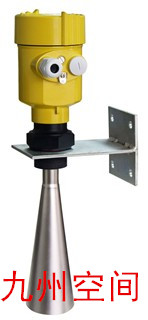Radar level gauges are widely used in metallurgy, building materials, energy, petrochemical, water conservancy, food and other industries. It is a high-tech product that uses microwave technology to detect the material level. The material level meter uses microwaves with good penetrability, strong adaptability to harsh environments and materials to be tested, and adopts the world's advanced large-scale integrated circuits, using radar. Principles, digital signal processing techniques and Fast Fourier Transform (FFT) techniques. It adopts continuous turbulent measurement to measure the liquid, solid (block, powder) material level, and has the characteristics of long distance measurement and high precision. Radar level meter detection method: 1. Investigation method Use vision, smell, and touch. In some cases, the damaged component will change color, blister or appear to be burnt mottled; the burnt device will have some special odor; the short-circuited chip will be hot; the virtual welding or de-soldering can also be investigated with the naked eye. . 2, tapping method When the radar level gauge was found to be good or bad, most of this scene was caused by poor touch or solder joints. With regard to this situation, tapping and hand pressing can be used. The so-called "knocking" is the part that may be afflicted with a problem. Lightly hit the board or parts with a small rubber plaque or other tapping material to see if it will cause mistakes or downtime. The so-called "hand pressure" is when the fault is present, after the power is turned off, the inserted components and the plug and the seat are firmly pressed from the head, and it is not necessary to try to eliminate the problem. If you find that the casing is normal and the hit is not normal, it is best to re-insert all the joints and try again. 3, replacement method Request two instruments of the same type or have enough spare parts. Replace a good spare with the same equipment on the disease machine to see if the problem is eliminated. 4, the exclusion method The so-called elimination method is a method of judging the factors of the disease through some plug-in boards and equipment in the plug-in machine. When the appearance of a plug-in board or equipment is removed, the appearance of the disease is normal. 5, lifting temperature method Sometimes the appearance of the work for a long time, or in the summer when the operating environment temperature is high, it will be faulty, shut down and view normal, stop for a while and then turn on the normal and normal, and then there is a problem. This phenomenon is caused by the poor function of a single IC or metadevice, and the high temperature characteristic parameters are not caused by the target request. In order to find out the metal processing network of the disease factor, the temperature rise and fall method can be selected. The so-called cooling, that is, when the problem occurs, use cotton fiber to wipe the anhydrous alcohol in the area where it may be faulty, to cool it, and investigate whether the problem is eliminated. The so-called warming is to artificially raise the ambient temperature, for example, using a soldering iron to close the suspected part (note that the temperature should not rise too high to damage the normal equipment) to see if the problem is present. 6, the comparison method Two sets of smart radar level gauges of the same type are requested and one is in normal operation. Use this method to have the necessary equipment, such as a multimeter, an oscilloscope, and so on. According to the nature of the comparison, voltage contrast, waveform contrast, static impedance contrast, output comparison, current contrast, etc. The specific method is: let the faulty appearance and the normal appearance run under the same conditions, then check the signal of some points and compare the two groups of signals measured. If there is a difference, it can be judged that the problem is here. This approach requires the repairer to have appropriate common sense and skills. 7, riding the shoulder method The shoulder method is also called parallel method. Place a good IC chip on the chip to be viewed, or connect the good meta-device (resistance capacitor, diode, triode, etc.) in parallel with the meta-device to be viewed, and stick to the excellent touch. If the problem is caused by the internal opening of the device or If you have a bad touch, etc., you can use this method to eliminate it. 8, isolation method Fault isolation does not require the same type of equipment or spare parts for comparison and is safe and reliable. According to the fault check flow chart, the cutting and surrounding gradually narrowing the search range of the fault, and then the cooperation signal comparison, component exchange and other methods, usually quickly find the location of the problem. 9, capacitor bypass method When a circuit has a strange contrast, such as a display disorder, it can be determined by a capacitor bypass method. 10. Condition adjustment method Generally speaking, before the fault is determined, do not randomly touch the meta-devices in the circuit, especially the adjustable equipment, such as potentiometers. However, if the reference method is adopted beforehand (for example, position mark or measured voltage value or resistance value before untouched), it is still allowed to be moved if necessary. Maybe after the change, sometimes the problem will be eliminated. The power and ground of the IC, the transistor circuit is connected across the base input or the collector output to investigate the impact on the fault scene. If the faulty input of the capacitor bypass is ineffective and the fault disappears when bypassing its output, then it is concluded that the fault is present in this stage of the circuit. School Furniture,Writing School Desk,Classroom School Table,Metal Foot School Chairs AU-PINY FURNITURE CO., LTD , https://www.jmaupiny.com